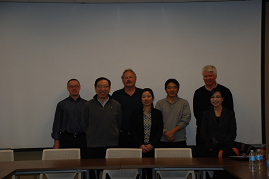
Abstract
Effective planning and management of transportation infrastructure requires adequate geospatial data. Existing geospatial data acquisition techniques based on conventional route surveys are very time consuming, labor intensive, and costly. Mobile laser scanning (MLS) technology enables a rapid collection of enormous volumes of highly dense, irregularly distributed, accurate geo-referenced point cloud data in the format of three-dimensional (3D) point clouds. Today, more and more commercial MLS systems are available for transportation applications. However, many transportation engineers have neither interest in the 3D point cloud data nor know how to transform such data into their computer-aided model (CAD) formatted geometric road information. Therefore, automated methods and software tools for rapid and accurate extraction of 2D/3D road information from the MLS data are urgently needed.
This doctoral dissertation deals with the development and implementation aspects of a novel strategy for the automated extraction of road information from the MLS data. The main features of this strategy include: (1) the extraction of road surfaces from large volumes of MLS point clouds, (2) the generation of 2D geo-referenced feature (GRF) images from the road-surface data, (3) the exploration of point density and intensity of MLS data for road-marking extraction, and (4) the extension of tensor voting (TV) for curvilinear pavement crack extraction. In accordance with this strategy, a RoadModeler prototype with three computerized algorithms was developed. They are: (1) road-surface extraction, (2) road-marking extraction, and (3) pavement-crack extraction. Four main contributions of this development can be summarized as follows.
Firstly, a curb-based approach to road surface extraction with assistance of the vehicle’s trajectory is proposed and implemented. The vehicle’s trajectory and thefunction of curbs that separate road surfaces from sidewalks are used to efficiently separate road-surface points from large volume of MLS data. The accuracy of extracted road surfaces is validated with manually selected reference points.
Secondly, the extracted road enables accurate detection of road markings and cracks for transportation-related applications in road traffic safety. To further improve computational efficiency, the extracted 3D road data are converted into 2D image data, termed as a GRF image. The GRF image of the extracted road enables an automated road-marking extraction algorithm and an automated crack detection algorithm, respectively.
Thirdly, the automated road-marking extraction algorithm applies a point-density-dependent, multi-thresholding segmentation to the GRF image to overcome unevenly distributed intensity caused by the scanning range, the incidence angle, and the surface characteristics of an illuminated object. The morphological operation is then implemented to deal with the presence of noise and incompleteness of the extracted road markings.
Fourthly, the automated crack extraction algorithm applies an iterative tensor voting (ITV) algorithm to the GRF image for crack enhancement. The tensor voting, a perceptual organization method that is capable of extracting curvilinear structures from the noisy and corrupted background, is explored and extended into the field of crack detection.
The successful development of three algorithms suggests that the RoadModeler strategy offers a solution to the automated extraction of road information from the MLS data. Recommendations are given for future research and development to be conducted to ensure that this progress goes beyond the prototype stage and towards everyday use.